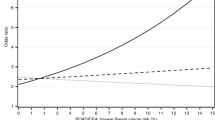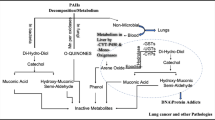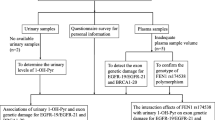Abstract
Purpose
Polycyclic aromatic hydrocarbons (PAHs) are a group of environmental pollutants associated with multiple cancers, including female breast cancer. Several xenobiotic metabolism genes (XMGs), including the CYP450 family, play an important role in activating and detoxifying PAHs, and variations in the activity of the enzymes they encode can impact this process. This study aims to examine the association between XMGs and breast cancer, and to assess whether these variants modify the effects of PAH exposure on breast cancer risk.
Methods
In a case–control study in Vancouver, British Columbia, and Kingston, Ontario, 1037 breast cancer cases and 1046 controls had DNA extracted from blood or saliva and genotyped for 138 single nucleotide polymorphisms (SNPs) and tagSNPs in 27 candidate XMGs. Occupational PAH exposure was assessed using a measurement-based job-exposure matrix.
Results
An association between genetic variants and breast cancer was observed among six XMGs, including increased risk among the minor allele carriers of AKR1C3 variant rs12387 (OR 2.71, 95% CI 1.42–5.19) and AKR1C4 variant rs381267 (OR 2.50, 95% CI 1.23–5.07). Heterogeneous effects of occupational PAH exposure were observed among carriers of AKR1C3/4 variants, as well as the PTGS2 variant rs5275.
Conclusion
Our findings support an association between SNPs of XMGs and female breast cancer, including novel genetic variants that modify the toxicity of PAH exposure. These results highlight the interplay between genetic and environmental factors, which can be helpful in understanding the modifiable risks of breast cancer and its complex etiology.


Similar content being viewed by others
References
IARC Working Group on the Evaluation of Carcinogenic Risks to Humans. Some non-heterocyclic polycyclic aromatic hydrocarbons and some related exposures. In: IARC monographs on the evaluation of carcinogenic risks to humans, vol. 92. Lyon: International Agency for Research on Cancer; 2010.
Petralia SA, Vena JE, Freudenheim JL, Dosemeci M, Michalek A, Goldberg MS, Brasure J, Graham S. Risk of premenopausal breast cancer in association with occupational exposure to polycyclic aromatic hydrocarbons and benzene. Scand J Work Environ Health 1999;25(3):215–221.
Hansen J. Elevated risk for male breast cancer after occupational exposure to gasoline and vehicular combustion products. Am J Ind Med. 2000;37(4):349–52.
Labreche F, Goldberg MS, Valois M-F, Nadon L. Postmenopausal breast cancer and occupational exposures. Occup Environ Med. 2010;67(4):263–9.
Lee DG, Burstyn I, Lai AS, Grundy A, Friesen MC, Aronson KJ, Spinelli JJ. Women’s occupational exposure to polycyclic aromatic hydrocarbons and risk of breast cancer. Occup Environ Med. 2019;76(1):22–9.
Rendic S, Carlo FJD. Human cytochrome P450 enzymes: a status report summarizing their reactions, substrates, inducers, and inhibitors. Drug Metab Rev. 1997;29(1–2):413–580.
Anzenbacher P, Anzenbacherova E. Cytochromes P450 and metabolism of xenobiotics. Cell Mol Life Sci CMLS. 2001;58(5–6):737–47.
Sims P, Grover P. Epoxides in polycyclic aromatic hydrocarbon metabolism and carcinogenesis. Adv Cancer Res. 1974;20:165–274.
Gelboin HV. Benzo [alpha] pyrene metabolism, activation and carcinogenesis: role and regulation of mixed-function oxidases and related enzymes. Physiol Rev. 1980;60(4):1107–66.
Conney AH. Induction of microsomal enzymes by foreign chemicals and carcinogenesis by polycyclic aromatic hydrocarbons: GHA clowes memorial lecture. Can Res. 1982;42(12):4875–917.
Shimada T, Fujii-Kuriyama Y. Metabolic activation of polycyclic aromatic hydrocarbons to carcinogens by cytochromes P450 1A1 and1B1. Cancer Sci. 2004;95(1):1–6.
Baird WM, Hooven LA, Mahadevan B. Carcinogenic polycyclic aromatic hydrocarbon-DNA adducts and mechanism of action. Environ Mol Mutagen. 2005;45(2–3):106–14.
Shimada T. Xenobiotic-metabolizing enzymes involved in activation and detoxification of carcinogenic polycyclic aromatic hydrocarbons. Drug Metab Pharmacokinet. 2006;21(4):257–76.
Chaloupka K, Krishnan V, Safe S. Polynuclear aromatic hydrocarbon carcinogens as antiestrogens in MCF-7 human breast cancer cells: role of the Ah receptor. Carcinogenesis. 1992;13(12):2233–9.
Santodonato J. Review of the estrogenic and antiestrogenic activity of polycyclic aromatic hydrocarbons: relationship to carcinogenicity. Chemosphere. 1997;34(4):835–48.
Arcaro KF, O’Keefe PW, Yang Y, Clayton W, Gierthy JF. Antiestrogenicity of environmental polycyclic aromatic hydrocarbons in human breast cancer cells. Toxicology. 1999;133(2):115–27.
Larsen MC, Angus WG, Brake PB, Eltom SE, Sukow KA, Jefcoate CR. Characterization of CYP1B1 and CYP1A1 expression in human mammary epithelial cells: role of the aryl hydrocarbon receptor in polycyclic aromatic hydrocarbon metabolism. Can Res. 1998;58(11):2366–74.
Huang C-S, Chern H-D, Chang K-J, Cheng C-W, Hsu S-M, Shen C-Y. Breast cancer risk associated with genotype polymorphism of the estrogen-metabolizing genes CYP17, CYP1A1, and COMT A multigenic study on cancer susceptibility. Can Res. 1999;59(19):4870–5.
Williams JA, Phillips DH. Mammary expression of xenobiotic metabolizing enzymes and their potential role in breast cancer. Can Res. 2000;60(17):4667–77.
Kristensen VN, Harada N, Yoshimura N, Haraldsen E, Lønning P, Erikstein B, Kåresen R, Kristensen T, Børresen-Dale A-L. Genetic variants of CYP19 (aromatase) and breast cancer risk. Breast Cancer Res. 2000;2(Suppl 1):1–2.
Zheng W, Xie D-W, Jin F, Cheng J-R, Dai Q, Wen W-Q, Shu X-O, Gao Y-T. Genetic polymorphism of cytochrome P450–1B1 and risk of breast cancer. Cancer Epidemiol Biomark Prev. 2000;9(2):147–50.
Rundle A, Tang D, Zhou J, Cho S, Perera F. The association between glutathione S-transferase M1 genotype and polycyclic aromatic hydrocarbon-DNA adducts in breast tissue. Cancer Epidemiol Biomark Prev. 2000;9(10):1079–85.
Firozi PF, Bondy ML, Sahin AA, Chang P, Lukmanji F, Singletary ES, Hassan MM, Li D. Aromatic DNA adducts and polymorphisms of CYP1A1, NAT2, and GSTM1 in breast cancer. Carcinogenesis. 2002;23(2):301–6.
Terry MB, Gammon MD, Zhang FF, Eng SM, Sagiv SK, Paykin AB, Wang Q, Hayes S, Teitelbaum SL, Neugut AI. Polymorphism in the DNA repair gene XPD, polycyclic aromatic hydrocarbon-DNA adducts, cigarette smoking, and breast cancer risk. Cancer Epidemiol Biomark Prev. 2004;13(12):2053–8.
Shen J, Gammon MD, Terry MB, Wang L, Wang Q, Zhang F, Teitelbaum SL, Eng SM, Sagiv SK, Gaudet MM. Polymorphisms in XRCC1 modify the association between polycyclic aromatic hydrocarbon-DNA adducts, cigarette smoking, dietary antioxidants, and breast cancer risk. Cancer Epidemiol Biomark Prev. 2005;14(2):336–42.
Crew KD, Gammon MD, Terry MB, Zhang FF, Zablotska LB, Agrawal M, Shen J, Long C-M, Eng SM, Sagiv SK. Polymorphisms in nucleotide excision repair genes, polycyclic aromatic hydrocarbon-DNA adducts, and breast cancer risk. Cancer Epidemiol Biomark Prev. 2007;16(10):2033–41.
Gammon MD, Sagiv SK, Eng SM, Shantakumar S, Gaudet MM, Teitelbaum SL, Britton JA, Terry MB, Wang LW, Wang Q. Polycyclic aromatic hydrocarbon-DNA adducts and breast cancer: a pooled analysis. Arch Environ Health Int J. 2004;59(12):640–9.
Ambrosone CB, Freudenheim JL, Graham S, Marshall JR, Vena JE, Brasure JR, Michalek AM, Laughlin R, Nemoto T, Gillenwater KA, et al. Cigarette smoking, N-acetyltransferase 2 genetic polymorphisms, and breast cancer risk. J Am Med Assoc. 1996;276(18):1494–501.
Ishibe N, Hankinson SE, Colditz GA, Spiegelman D, Willett WC, Speizer FE, Kelsey KT, Hunter DJ. Cigarette smoking, cytochrome P450 1A1 polymorphisms, and breast cancer risk in the Nurses’ Health Study. Can Res. 1998;58(4):667–71.
Zheng W, Deitz AC, Campbell DR, Wen W-Q, Cerhan JR, Sellers TA, Folsom AR, Hein DW. N-Acetyltransferase 1 genetic polymorphism, cigarette smoking, well-done meat intake, and breast cancer risk. Cancer Epidemiol Biomark Prev. 1999;8(3):233–9.
Grundy A, Richardson H, Burstyn I, Lohrisch C, SenGupta SK, Lai AS, Lee D, Spinelli JJ, Aronson KJ. Increased risk of breast cancer associated with long-term shift work in Canada. Occup Environ Med. 2013;70(12):831–8.
Lee DG, Lavoue J, Spinelli JJ, Burstyn I. Statistical modelling of occupational exposure to polycyclic aromatic hydrocarbons using osha data. J Occup Environ Hyg. 2014;70(1):14.
Agency for Toxic Substances and Disease Registry. Toxicological profile for polycyclic aromatic hydrocarbons. 1995.
Nilsson S, Mäkelä S, Treuter E, Tujague M, Thomsen J, Andersson G, Enmark E, Pettersson K, Warner M, Gustafsson J-Å. Mechanisms of estrogen action. Physiol Rev. 2001;81(4):1535–65.
Ohtake F, Takeyama K, Matsumoto T, Kitagawa H, Yamamoto Y, Nohara K, Tohyama C, Krust A, Mimura J, Chambon P. Modulation of oestrogen receptor signalling by association with the activated dioxin receptor. Nature. 2003;423(6939):545–50.
de Bakker PI, Yelensky R, Pe’er I, Gabriel SB, Daly MJ, Altshuler D. Efficiency and power in genetic association studies. Nat Genet. 2005;37(11):1217–23.
Barrett JC, Fry B, Maller J, Daly MJ. Haploview: analysis and visualization of LD and haplotype maps. Bioinformatics. 2005;21(2):263–5.
Purcell S, Neale B, Todd-Brown K, Thomas L, Ferreira MA, Bender D, Maller J, Sklar P, De Bakker PI, Daly MJ. PLINK: a tool set for whole-genome association and population-based linkage analyses. Am J Hum Genet. 2007;81(3):559–75.
Abecasis GR, Cherny SS, Cookson W, Cardon LR. GRR: graphical representation of relationship errors. Bioinformatics. 2001;17(8):742–3.
Consortium IH. Integrating common and rare genetic variation in diverse human populations. Nature. 2010;467(7311):52–8.
Devlin B, Roeder K, Wasserman L. Genomic control for association studies: a semiparametric test to detect excess-haplotype sharing. Biostatistics. 2000;1(4):369–87.
Devlin B, Roeder K, Wasserman L. Genomic control, a new approach to genetic-based association studies. Theor Popul Biol. 2001;60(3):155–66.
Devlin B, Bacanu S-A, Roeder K. Genomic control to the extreme. Nat Genet. 2004;36(11):1129–30.
Devlin B, Roeder K. Genomic control for association studies. Biometrics. 1999;55(4):997–1004.
Thomas DC, Witte JS. Point: population stratification: a problem for case–control studies of candidate-gene associations? Cancer Epidemiol Biomark Prev. 2002;11(6):505–12.
Anderson CA, Pettersson FH, Clarke GM, Cardon LR, Morris AP, Zondervan KT. Data quality control in genetic case-control association studies. Nat Protoc. 2010;5(9):1564–73.
Schuetz JM, Daley D, Graham J, Berry BR, Gallagher RP, Connors JM, Gascoyne RD, Spinelli JJ, Brooks-Wilson AR. Genetic variation in cell death genes and risk of non-Hodgkin lymphoma. PLoS ONE. 2012;7(2):e31560.
Benjamini Y, Hochberg Y. Controlling the false discovery rate: a practical and powerful approach to multiple testing. J R Stat Soc Ser B (Methodological). 1995;57(1):289–300.
Johnson KC, Miller AB, Collishaw NE, Palmer JR, Hammond SK, Salmon AG, Cantor KP, Miller MD, Boyd NF, Millar J. Active smoking and secondhand smoke increase breast cancer risk: the report of the Canadian Expert Panel on Tobacco Smoke and Breast Cancer Risk (2009). Tob Control. 2010;20(1):e2.
White AJ, Bradshaw PT, Herring AH, Teitelbaum SL, Beyea J, Stellman SD, Steck SE, Mordukhovich I, Eng SM, Engel LS. Exposure to multiple sources of polycyclic aromatic hydrocarbons and breast cancer incidence. Environ Int. 2016;89:185–92.
Palackal NT, Lee SH, Harvey RG, Blair IA, Penning TM. Activation of polycyclic aromatic hydrocarbon trans-dihydrodiol proximate carcinogens by human aldo–keto reductase (AKR1C) enzymes and their functional overexpression in human lung carcinoma (A549) cells. J Biol Chem. 2002;277(27):24799–808.
Penning TM, Burczynski ME, Hung C-F, McCoull KD, Palackal NT, Tsuruda LS. Dihydrodiol dehydrogenases and polycyclic aromatic hydrocarbon activation: generation of reactive and redox active o-quinones. Chem Res Toxicol. 1999;12(1):1–18.
Zhang L, Jin Y, Huang M, Penning TM. The role of human aldo-keto reductases (AKRs) in the metabolic activation and detoxication of polycyclic aromatic hydrocarbons: interconversion of PAH-catechols and PAH o-Quinones. Front Pharmacol. 2012;3:193-204.
Lin H-K, Steckelbroeck S, Fung K-M, Jones AN, Penning TM. Characterization of a monoclonal antibody for human aldo-keto reductase AKR1C3 (type 2 3α-hydroxysteroid dehydrogenase/type 5 17β-hydroxysteroid dehydrogenase); immunohistochemical detection in breast and prostate. Steroids. 2004;69(13):795–801.
Byrns MC, Steckelbroeck S, Penning TM. An indomethacin analogue, N-(4-chlorobenzoyl)-melatonin, is a selective inhibitor of aldo-keto reductase 1C3 (type 2 3α-HSD, type 5 17β-HSD, and prostaglandin F synthase), a potential target for the treatment of hormone dependent and hormone independent malignancies. Biochem Pharmacol. 2008;75(2):484–93.
Reding KW, Li CI, Weiss NS, Chen C, Carlson CS, Duggan D, Thummel KE, Daling JR, Malone KE. Genetic variation in the progesterone receptor and metabolism pathways and hormone therapy in relation to breast cancer risk. Am J Epidemiol. 2009;170:1241–9.
Penning TM, Byrns MC. Steroid hormone transforming aldo–keto reductases and cancer. Ann N Y Acad Sci. 2009;1155(1):33–42.
Multigner L, Ndong JR, Giusti A, Romana M, Delacroix-Maillard H, Cordier S, Jégou B, Thome JP, Blanchet P. Chlordecone exposure and risk of prostate cancer. J Clin Oncol. 2010;28(21):3457–62.
Ebright RH, Wong JR, Chen LB. Binding of 2-hydroxybenzo (a) pyrene to estrogen receptors in rat cytosol. Can Res. 1986;46(5):2349–51.
Justenhoven C, Hamann U, Pierl CB, Baisch C, Harth V, Rabstein S, Spickenheuer A, Pesch B, Brüning T, Winter S. CYP2C19* 17 is associated with decreased breast cancer risk. Breast Cancer Res Treat. 2009;115(2):391–6.
Justenhoven C, Obazee O, Winter S, Couch FJ, Olson JE, Hall P, Hannelius U, Li J, Humphreys K, Severi G. The postmenopausal hormone replacement therapy-related breast cancer risk is decreased in women carrying the CYP2C19* 17 variant. Breast Cancer Res Treat. 2012;131(1):347–50.
Chen GG, Zeng Q, Tse GM. Estrogen and its receptors in cancer. Med Res Rev. 2008;28(6):954–74.
Wang J, Higuchi R, Modugno F, Li J, Umblas N, Lee J, Lui L-Y, Ziv E, Tice JA, Cummings SR, et al. Estrogen receptor alpha haplotypes and breast cancer risk in older Caucasian women. Breast Cancer Res Treat. 2007;106(2):273–80.
Hein DW. N-Acetyltransferase genetics and their role in predisposition to aromatic and heterocyclic amine-induced carcinogenesis. Toxicol Lett. 2000;112:349–56.
Hein DW, Doll MA, Fretland AJ, Leff MA, Webb SJ, Xiao GH, Devanaboyina U-S, Nangju NA, Feng Y. Molecular genetics and epidemiology of the NAT1 and NAT2 acetylation polymorphisms. Cancer Epidemiol Biomark Prev. 2000;9(1):29–42.
Penning TM, Ohnishi ST, Ohnishi T, Harvey RG. Generation of reactive oxygen species during the enzymatic oxidation of polycyclic aromatic hydrocarbon trans-dihydrodiols catalyzed by dihydrodiol dehydrogenase. Chem Res Toxicol. 1996;1:84–92.
Burczynski ME, Harvey RG, Penning TM. Expression and characterization of four recombinant human dihydrodiol dehydrogenase isoforms: oxidation of trans-7, 8-dihydroxy-7, 8-dihydrobenzo [a] pyrene to the activated o-quinone metabolite benzo [a] pyrene-7, 8-dione. Biochemistry. 1998;37(19):6781–90.
Jin Y, Penning TM. Aldo–keto reductases and bioactivation/detoxication. Annu Rev Pharmacol Toxicol. 2007;47:263–92.
Dong LM, Potter JD, White E, Ulrich CM, Cardon LR, Peters U. Genetic susceptibility to cancer: the role of polymorphisms in candidate genes. JAMA. 2008;299(20):2423–36.
Cox DG, Buring J, Hankinson SE, Hunter DJ. A polymorphism in the 3′ untranslated region of the gene encoding prostaglandin endoperoxide synthase 2 is not associated with an increase in breast cancer risk: a nested case–control study. Breast Cancer Res. 2007;9(1):R3.
Brueggemeier RW, Richards JA, Petrel TA. Aromatase and cyclooxygenases: enzymes in breast cancer. J Steroid Biochem Mol Biol. 2003;86(3):501–7.
Hwang D, Byrne J, Scollard D, Levine E. Expression of cyclooxygenase-1 and cyclooxygenase-2 in human breast cancer. J Natl Cancer Inst. 1998;90(6):455–60.
Soslow RA, Dannenberg AJ, Rush D, Woerner B, Khan KN, Masferrer J, Koki AT. COX-2 is expressed in human pulmonary, colonic, and mammary tumors. Cancer. 2000;89(12):2637–45.
Liu CH, Chang S-H, Narko K, Trifan OC, Wu M-T, Smith E, Haudenschild C, Lane TF, Hla T. Overexpression of cyclooxygenase-2 is sufficient to induce tumorigenesis in transgenic mice. J Biol Chem. 2001;276(21):18563–9.
Burstyn I, Lavoué J, Van Tongeren M. Aggregation of exposure level and probability into a single metric in job-exposure matrices creates bias. Ann Occup Hyg. 2012;56(9):1038–50.
Gustafson P. Measurement error and misclassification in statistics and epidemiology: impacts and Bayesian adjustments. Boca Raton: Chapman & Hall/CRC; 2004.
Gustafson P, Burstyn I. Bayesian inference of gene–environment interaction from incomplete data: What happens when information on environment is disjoint from data on gene and disease? Stat Med. 2011;30(8):877–89.
Burstyn I, Kim H-M, Yasui Y, Cherry NM. The virtues of a deliberately mis-specified disease model in demonstrating a gene–environment interaction. Occup Environ Med. 2009;66(6):374–80.
Terry PD, Rohan TE. Cigarette smoking and the risk of breast cancer in women a review of the literature. Cancer Epidemiol Biomark Prev. 2002;11(10):953–71.
Xue F, Willett WC, Rosner BA, Hankinson SE, Michels KB. Cigarette smoking and the incidence of breast cancer. Arch Intern Med. 2011;171(2):125–33.
Acknowledgements
The authors thank Dr. Chris Bajdik for his contributions to the study. The authors also thank Dr. Linda Warren (Screening Mammography Program of BC), Dr. Philip Switzer (Greig Associates), Caroline Speers (Breast Cancer Outcomes Unit, BC Cancer Agency), Agnes Bauzon, Alegria Imperial, Betty Hall, Lina Hsu, Maria Andrews and Teresa Pavlin for their assistance with participant recruitment and data collection in Vancouver. We also thank Dr. Ross Walker, Dr. Ralph George, Celine Morissette, Jane Warner, Hilary Rimmer, Meghan Hamel and Annie Langley for assistance with participant recruitment and data collection in Kingston. Funding for this study was provided by a grant from the Canadian Institutes of Health Research (Funding Reference #: 69036).
Funding
Funding for this study was provided by a grant from the Canadian Institutes of Health Research (Funding Reference #: 69036).
Author information
Authors and Affiliations
Corresponding author
Ethics declarations
Conflict of interest
The authors declare that they have no conflict of interest.
Ethics approval
Ethics approval was provided by the University of British Columbia/BC Cancer Research Ethics Board (R04-0142) and the Queen’s University Health Sciences Research Ethics Board (EPID156-03).
Informed consent
Informed consent was obtained from all individual participants included in the study. All participants provided informed consent prior to their inclusion, which could be withdrawn at any time for any reason.
Human and animal right
All procedures performed in studies involving human participants were in accordance with the ethical standards of the institutional and/or national research committee and with the 1964 Helsinki Declaration and its later amendments or comparable ethical standards.
Additional information
Publisher's Note
Springer Nature remains neutral with regard to jurisdictional claims in published maps and institutional affiliations.
Supplementary Information
Below is the link to the electronic supplementary material.
About this article
Cite this article
Lee, D.G., Schuetz, J.M., Lai, A.S. et al. Interactions between exposure to polycyclic aromatic hydrocarbons and xenobiotic metabolism genes, and risk of breast cancer. Breast Cancer 29, 38–49 (2022). https://doi.org/10.1007/s12282-021-01279-0
Received:
Accepted:
Published:
Issue Date:
DOI: https://doi.org/10.1007/s12282-021-01279-0




